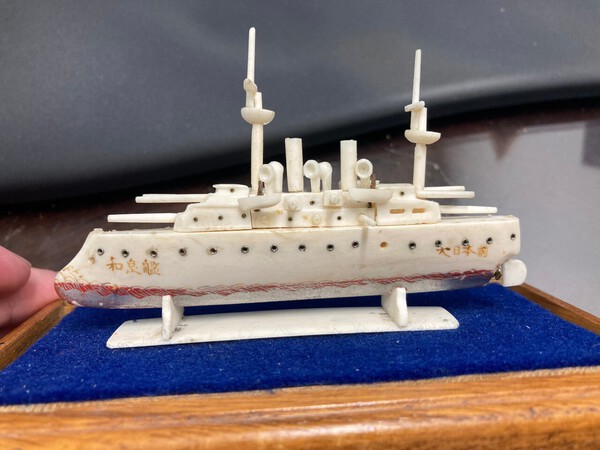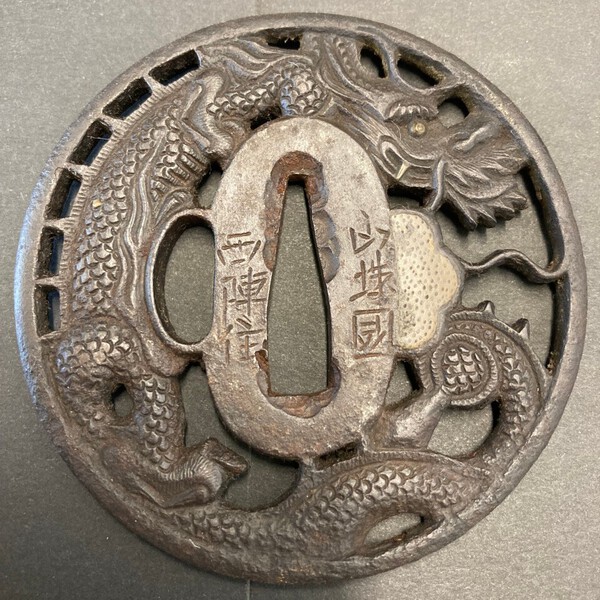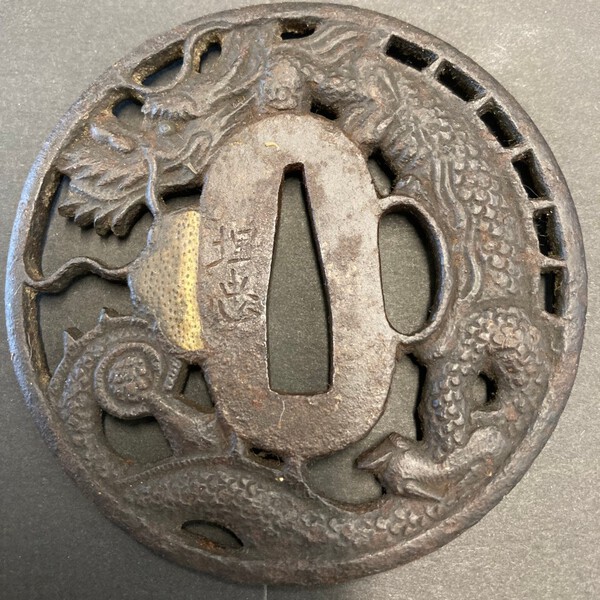
tbonesullivan
Members-
Posts
403 -
Joined
-
Last visited
Content Type
Profiles
Forums
Events
Store
Downloads
Gallery
Everything posted by tbonesullivan
-
Do you have any pictures of the entire blade, and the entire tang? Examination of the tang for the yasurime file marks as well as the tagane and tagane-makura can help to determine the age of a blade.
-
This is definitely out of left field, but I've been drawing kanji and hunting down radicals all day, and found nothing on this one character that appears twice on this little whalebone carving of the Cruiser IzumI. On the front of the ship is the name 和泉 ? (IZUMI ?), but there is a character after it that I cannot find anywhere. The same character is on the other side as well as part of ?軍國帝, which I assume translates to Imperial Japanese Navy. Does anyone know what character this is? Closest I could come up with is 艦, which is supposed to mean "Warship" but while that makes sense, it doesn't look quite right. It definitely has the radicals 舟 and 皿 in it. Any help would be much appreciated!
-
備中國家次 looks to be correct. How many did you find working in Bitchū province?
-
I looked at this a bunch, and first through it might be 久次作 - HISATSUGU SAKU, but the more I look at it I think it is actually 友次作 - TOMOTSUGU SAKU. Just wanted to get some other eyes on it, and maybe see if anyone has any information on which smith it is. There are a lot of TOMOTSUGU and HISATSUGU smiths. Thanks in advance!
-
Just got a chance to take a look at this Wakizashi, which is signed 尚定 - NAOSADA on the tang. I did find a listing for this smith at Nihonto club, but have not been able to find out much else. The signature on the blade is definitely old, and did have a bit of trouble with it, as the chisel marks are very faint. The file marks are also long gone. Fittings are very nice, though probably later than the blade, and the polish does look to be in very good shape, though the JI looks much closer to a mirror shine than I am used to seeing. I'm also trying to figure out what to term the HAMON shape. https://nihontoclub.com/smiths/NAO268
-
- 1
-

-
I would also say SEKI KANEKIYO SAKU - 関 兼 清 作 . Their name is in the Seki Tanrensho Booklet printed in 1939. It looks like there is an arsenal stamp above that, probably Showa (昭) inside a cherry blossom?
-
Can anyone help with this Mei?
tbonesullivan replied to Sifujohnholden's topic in Translation Assistance
Kanji should be 紀伊國 康綱 紀伊國 can be pronounced "KII NO KUNI", and is one of the ways the province of KII is referred to: https://en.wikipedia.org/wiki/Kii_Province This could be the maker: https://nihontoclub.com/smiths/YAS997 -
Just a quick question: any reason they used both forms of KUNI (国 and 國) in the mei? Usually in swordsmith names I always see 國, but in a province name I've seen both. 備 中 国 水 田 源 國 信 作
-
Can anyone help with this Mei?
tbonesullivan replied to Sifujohnholden's topic in Translation Assistance
I'm not seeing any pictures posted. Are you sure you attached / linked it correctly? -
I had the same thought. "Back in the day" people didn't really even care. I'm amazed at some of the things I've seen. The hilt fittings are all number matched, so it's a shame that the original scabbard was lost. Now if only it was an EMURA blade with one of the fancy Gunome Midare temper lines. I got out the 16X magnifier, but I can't see much of any activity in the hamon.
-
I haven't been stumped this much in a long time, so I hope it's just me not reading Kanji well, and not that the tang was marked post war with incorrect characters. The closest I could come with in Kanji is 仜 村 作 - KO/DA MURA SAKU. Now the first character is super rare, and I only found it by looking up the 工 radical. It also doesn't look quite right. The second looks close but I can barely find anything on that character being used to sign tangs. Any help would be most appreciated. I have no idea why it's in a Kai-Gunto scabbard, but I suspect it was probably swapped when it was being brought to the US, or later.
-
Yes, I can still see the chisel marks, though the raised area around isn't pronounced. This came in with a group of three, and the other two are younger blades, but definitely look older. All three were relatively recently polished. This one does have a very nice temper line. I tried to get pictures but it's not easy. Eventually I'll make some type of setup to better photograph blades with a phone camera.
-
This one kinda threw me for a loop for a while. Some of the characters are very close together, so I was having issues telling one from another at times, and also there are a bunch I have simply never seen on Nihonto before. The characters also are a bit stylized, which made them harder for me to recognize. There is one I still cannot decide on definitively, as it looks like 朱 ? As best I can tell, it reads: 金房隼人 ? 正真作 - KANABOU HAITANO ? MASAZANE SAKU I found two smiths which may be the same smith, but neither is quite a match. I also couldn't find ANY under 正真 MASAZANE, just under the similar 正眞 MASAZANE. https://nihontoclub.com/smiths/MAS855 https://nihontoclub.com/smiths/MAS849 Any help, tips, etc would be greatly appreciated!
-
I agree! This is not a hard one. You shouldn't need anything more than what is posted here: https://japaneseswor...com/kanji/kanji1.htm
-
This came in labeled simply as "Japanese Armor Piercing Dagger", and was mounted in tanto style koshirae. The blade is that of a Sankaku yari, but the tang is quite a bit shorter than I usually see on a yari, and does appear to have had the end of the tang cut off. It's got a Bo'Hi with Red urushi, which I'm used to seeing on pole arms. I checked close up and the blade definitely has lamination lines and such. I guess the question is, is this a normal type of alteration that was done? Is this what could be done if the tang ever broke? Is there an "official" name for this type of weapon? Any help would be greatly appreciated!
-
Mucking through this by hunting down radicals and hand drawing things has gotten me all but the last 1 or 2 kanji. I can't tell whether it's 一 ICHI followed by something else, or just something I can't recognize at all. The characters I have gotten so far are ペラ州 船第㭍佰参拾, and I am close to certain on these. It's supposed to be a flag from a WWII era Boat Squadron around the Perak River Region (ペラ州 ) in Malaya, however the rest of the kanji are quite old and I'm stumped. I also can't read the last two or figure out what they are supposed to be. Any help would be most appreciated, as machine translation has so far given us a bunch of strange answers.
-
Character on Type 44 Carbine Bayonet
tbonesullivan replied to tbonesullivan's topic in Translation Assistance
So I guess 福 高 woud just mean "good luck" or something similar? -
Just wondering if anyone has encountered these markings on a 1st Pattern Type 44 Folding Bayonet. The serial number さ896 is easy to see, and the Kanji on the upper left is 福, but I cannot find the upper right Kanji anywhere. The closest I could find is 官 which means "official"? Any help you can give would be most appreciated! There is not much on these bayonets and their markings at all out there.
-
Just found this on a "barn fresh" WWII Katana by AMAHIDE, and this definitely looks to have been made quite a bit before WWII. I've been working on trying to much through the kanji, but so far one one side I have been able to come up with 西陣住, with the other side having two characters I can't find followed by what I think is 國 - KUNI The other side has just two kanji, and they may be 忠 埋. This is my first attempt at a Tsuba, and I don't think I've ever seen these kanji before. Any help you can give is much appreciated!
-
Is there a way to tell if it is definitely oil quenched? I can see NIE at the transition, and there are some ASHI within the hamon, which does have that iridescent quality to it. I also am pretty sure the body of the blade has very tight MASAME hada, like other blades from the Meiji era I have seen. The scabbard definitely looks to be post WWII.




























